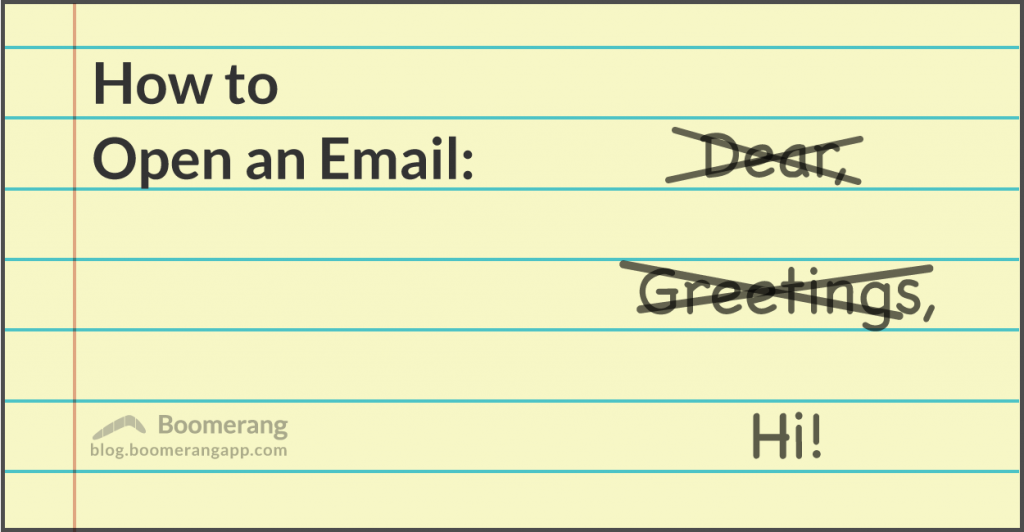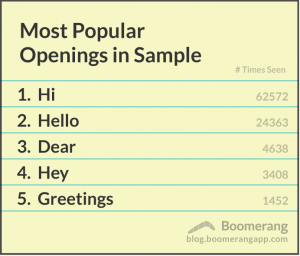
Every email has to start somehow. But (unless your name is Fetty Wap) you can only choose one salutation, whether it’s “Hey,” “What’s up,” “Hello,” or something else. So what’s the best way to start an email? We know that thankful email closings yield higher response rates, so let’s see if there are likewise any openings that tend to get more replies.
We used the same data we used to analyze email closings: a few hundred thousand threads from online communities that make their message archives public. We started off by looking at the first lines of each email and counting the relative occurrence of the opening word(s). Here are the five email openings that appeared 1000+ times.
These five openings are all pretty common, so it came as no surprise they were the most popular in our dataset. The distribution did surprise us a bit initially: “Hi” and “Hello” were by far the most common; combined they appeared 19 times more often than the more formal and traditional opening “Dear.”
Now for the moment of truth: did any of these openings correlate with an increase in email response rates? We looked at the opening used in over 300,000 threads and checked whether the thread got any replies. Here’s what we found:
| Email Opening | Response Rate |
|---|---|
| hey | 64.0% |
| hello | 63.6% |
| hi | 62.7% |
| greetings | 57.2% |
| dear | 56.5% |
| Baseline (all emails in sample) |
47.5% |
Every email opening we looked at, whether more formal (“Dear”) or more casual (“Hey”) correlated with an higher response rate than the corpus average. So while omitting a salutation on follow-up replies seems to be increasingly common, it looks like you are best off including an opening, at least in your initial email.

The top three openings fared pretty equally: emails that started with “Hey,” “Hello,” and “Hi” got a reply 63-64% of the time. Trailing the pack were the more formal openings: “Greetings” and “Dear” each got a reply 57% of the time. Perhaps we should move past the era of formal salutations, as messages that struck a more informal, conversational tone from the start got more responses. Using a conversational opening like “Hey,” “Hello,” or “Hi” yielded more responses than starting with a formal opening like “Dear” or “Greetings.” Interestingly enough, research cites that formality tends to be higher when there’s less shared context, as well as when speakers dislike each other, neither of which are ideal if you need a reply!
Before you toss “Dear” in the dustbin, keep in mind that the data we analyzed may not be representative of email data at large. Online communities tend to be more informal, so you might find a different distribution of openings, and different response rates across them, in more formal settings. The same research also showed that participants in online communication tend to mimic each other in the formality of their writing. So keep your audience in mind when you’re starting to write a new message.
That said, we still feel comfortable making a couple suggestions based on the data:
- Always use an opening! Emails with any of the openings we looked at (“Hey,” “Hello,” “Hi,” “Greetings,” and “Dear”) correlated with an increased response rate compared to the data-set average.
- If you’re writing an email where formality isn’t expected, start your message with “Hi,” “Hey,” or “Hello.” More conversational starts tend to get more replies.
And one final tip for those who want to write emails that get more responses: check out Respondable, a free feature built into Boomerang for Gmail and Boomerang for Outlook. Respondable analyzes your email in real-time and lets you know about changes that might help you get a reply! It’s one of many Boomerang features that help people email more productively.

Subject line is important. If subject is deceptive, salutation is irrelevant. I send fund-raising emails where the subject suggests news but are really asks directly to the trash. Salutations just take up band-width.
How to start an email … in order to ???
We agree that subject lines matter! That’s why we use subject lines in one of the components of Respondable (www.boomeranggmail.com/respondable).